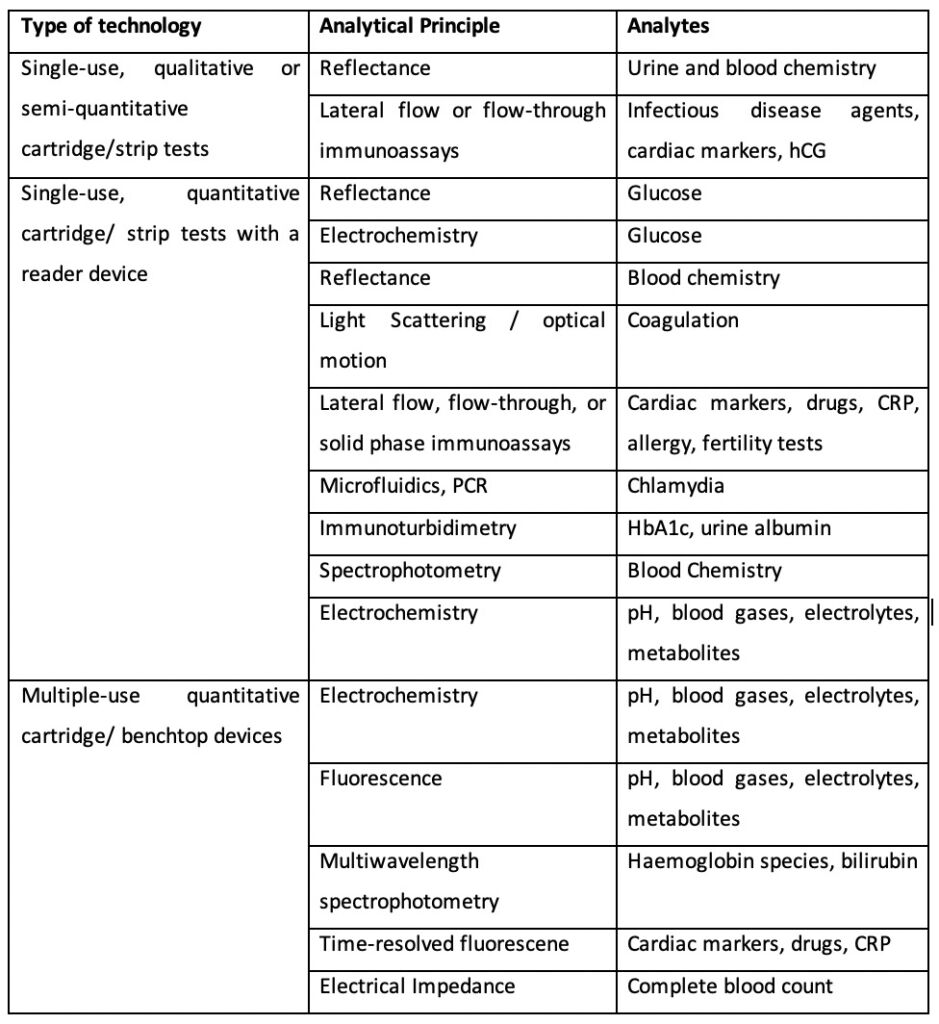
Introduction
The future is NOW !
We are increasingly seeing traditional examinations of a patient’s body fluids, excreta and tissues carried out generally in the controlled and regulated environment of a recognized medical laboratory being phased out.Advances in technology have resulted in compact, easy-to-use in vitro diagnostic (IVD) medical devices that make it possible for some examinations to be carried out at, or close to, the location of the patient.
POCT, also known as near-patient testing is defined as “testing that is performed near or at the site of a patient with the result leading to possible change in the care of the patient”. (International Standard ISO 22870).
POCT allows for faster clinical decisions in hospitals, physician’s offices, ambulances, patient homes, and in the field. Immediate clinical management decisions can be made by moving the test to the patient in which increases the likelihood that the patient, physician, and care team will receive the results faster. Besides, POCT will be a part of a successful shift from curative medicine to predictive, personalized, and pre-emptive medicine as a result of development, implementation, and connectivity of portable diagnostic and monitoring devices.
Difference between Conventional Testing & POCT

Conventional way of testing involves collecting test sample from patients and sample is sent to a lab for analysis, which takes approximately several days and may require several patient’s visits.
POCT makes results to be obtained at a quick and reliable manner. With these results made available, medical personnel can make informed decisions about a patient’s treatment and care. POCT does not need to be performed by a trained medical or lab personnel. It can be done by nurse, doctor or even patients themselves.
Advantages of POCT
- Quicker Turn Around Time (TAT)
- Simple steps procedure
- Enables Rapid Medical Decision to improve patient’s care
- Remote testing at a variety of locations
- Avoid sample identification & transport issues
- Only small sample needed
- Increase provider and patient satisfaction
- Reduce hospital admissions
- Optimizing drug treatments
- Optimizing clinical efficiency and use of staff time
Types of POCT Technology


Trends in Healthcare
The advancement of virtual technology and POCT have literally opened up new horizons in the field of medicine. The number of patients requiring inpatient treatment in a hospital, together with the length of their stay, is likely to decline further in the near future. This is surely an advantage to outpatient treatment and patient observation in their home environment. Undoubtedly, the importance of POCT will increase in these areas.
“Telemedicine” is increasingly important in this area. Instruments used to monitor the patient can, in the right circumstances, send the data obtained directly to the relevant medical service point, which can intervene (e.g., when critical values are exceeded). The effectiveness of home monitoring and thus patient safety are improved. With new developments and opportunities, it is the responsibilities of global players of medicine to exercise corporate responsibility.
CLEADOC is making test integrity of POCT next level !
CLEADOC provides the best verification method by preventing test frauds, misinterpretations and possible errors for doctors and users in the field of next generation POCTs.







CLEADOC is also committed to on-going research and development for future POCT. We are embarking on new ventures with collaborations from reputed research varsities like universities and the public health authorities to help advance the cause of future medical treatments and many more interesting upcoming developments.
We are pleased to announce our collaboration with UCSI pertaining to POCT; and indeed it is yet another milestone for (CLEA) in the field of telemedicine. This includes exclusive exchange of scientific ideas, tech and algorithmic knowledge surrounding this bilateral cooperation. Both parties will be collaborating closely and agree to create meaningful research studies with available infrastructure and data points. We are now seriously into:
- Researching on mobile-app based large scale covid-19 screening
- Quantitative analysis and comparison for the viability of professional supervised self-test over professionally-administered test.
- Optimizing integrity of remote POCT with AI in telemedicine.
- Smart technology and Internet of Things (IOT) integration for infectious disease control.
- Qualitative and viability study about health analytic by AI using genome data points and machine learning.
No doubt, these are indeed challenging yet exciting times for the world of telemedicine. We, at CLEADOC, are committed to bring affordable, comfortable, safe, prompt and convenient yet trusted and certified POCT to the doorstep of every one out there! We know and appreciate the time-tested value of integrity and hence we are committed to honouring this esteemed principle when reaching out to the needs of our valued clients/ patients.
References:
- ISO 22870 (2016) Point-of-care testing (POCT) – Requirements for quality and competence, available at: https://www.iso.org/obp/ui/#iso:std:iso:22870:ed-2:v1:en
- Christopher P Price, Andrew St John (2016) Point of care testing, Basic medical key, available at: https://basicmedicalkey.com/point-of-care-testing-4/
- Peter B Luppa, Carolin Muller, Alice Schlichtiger, Harald Schlebusch (2011) Point of care testing: Current techniques and future perspectives, TrAC trends in Analutical Chemistry 2011 June: 30(6): 887-898, available at: https://www.sciencedirect.com/science/article/pii/S0165993611000860#f0020
- Umesh Gami, Raji Pillai, Susan Cherian (2018) Emerging Technology for Point of care (POCT) testing: A future outlook for Scientists and Engineers, Pathology Unit, Medical Division, Bhabha Atomic Research Centre, Anushakti Nagar, Mumbai
Useful link : https://www.facebook.com/176967757750122/posts/330771089036454/?d=n
CLEADOC Official Website : https://cleadoc.com

